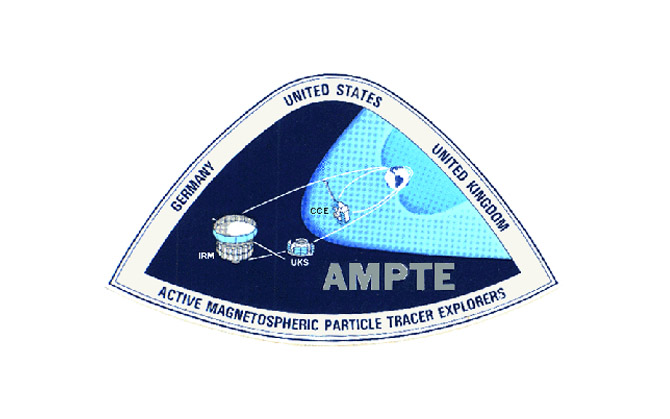The Active Magnetospheric Particle Tracer Explorer (AMPTE)
Measure particles and fields in the near-Earth plasma environmet - A. Johnstone, PI of UKS ion instrument - (1984-1985)

6 August 1977
The Mission
The Active Magnetospheric Particle Tracer Explorer mission was designed to
- Investigate the transfer of mass and energy from the solar wind to the magnetosphere
- study the interaction between artificial and natural space plasmas
- to establish the composition and dynamics of the charged population in the magnetosphere over a broad energy range.
The Spacecraft
This was a three-nation project consisting of three satellites, the German Ion Release Module (IRM), the US Charge Composition Explorer (CCE) and the UK Subsatellite (UKS). All three satellites were launched by a single Delta rocket on 16th August 1984. IRM and UKS were placed in nearly identical orbits of high eccentricity that carried them regularly through the magnetopause and bow shock and into the solar wind. CCE was placed in a near-equatorial orbit with smaller eccentricity to maximize coverage of the ring current.
CCE IRM UKS Apogee 8.8Re 18.7Re 18.7Re Period 15.6hrs 44.3hrs 44.3hrs Inclination <5deg 28.8deg 28.8deg Mass 242kg 705kg 77kg
For further general information you may wish to connnect to the Ampte page of the U.S.A.'s National Space Science Data Center.
IRM, the largest of the three satellites (with a mass of 705 kg at launch), was built by the Max Planck Institute for Physics and Astrophysics. As its name suggests it was equipped with 16 canisters of either Lithium or of Barium which, on being ejected and 'opened' (a safe distance from the spacecraft!) generated clouds of neutral atoms which were quite rapidly ionised by sunlight. The ions then interact with their local space plasma environment. Comets generate a neutral gas cloud too (called the coma) when they come 'close' to the Sun, which is also ionised by sunlight, thus studies of the releases have helped us to understand some of the processes of cometary interactions with the solar wind. The ion releases were performed in the solar wind, magnetosheath and geomagnetic tail. UKS monitored the process from close range while CCE was stationed (during dayside releases) downstream of IRM so as to detect ions any ions which penetrated the magnetopause. Lithium and Barium are good 'tracer ions' since they are unusual in naturally occuring space plasmas, so a detection would almost certainly indicate that IRM had been the source). It was hoped that the record of when and where detections occurred would tell us about how ions are transported from the magnetosheath into the magnetosphere, and throughout the magnetosphere.
CCE (mass 242 kg) developed by the Applied Physics Laboratory of The Johns Hopkins University, observed the ring current and plasma sheet. It carried out sensitive measurements of plasma composition as well as having a special role in the attempt to detect ions released by IRM when IRM was upstream of CCE. For further information about CCE, its instruments and data archive you may wish to connect to The AMPTE Science Data Center at the Johns Hopkins University/Applied Physics Laboratory in the U.S.A.
UKS was developed by the Mullard Space Science Laboratory and the Rutherford-Appleton Laboratory. At 77 kg it has a mass virtually a tenth that of the IRM! It carried an electron spectrometer, an ion spectrometer, a particle correlator, a magnetometer and a plasma wave detector. During the chemical releases, the proximity of UKS and IRM meant that instruments aboard UKS saw the magnetic cavity created by the ionized gas. Differences in observations at IRM and UKS were used to infer the spatial structure and evolution of the comet-like gas cloud.
All three satellites were also used independently to study the magnetosphere, magnetosheath, solar wind and the boundaries between them. The Geophysical Data Facility at Rutherford-Appleton Laborotory contains a database of AMPTE-UKS and IRM data. (As noted above CCE data is stored in the U.S.A.).
The AMPTE UKS Ion Instrument
Built by the Mullard Space Science Laboratory, this comprised two electrostatic analysers. The instrument measured ions in the energy range 10 eV to 20 keV. The energy range was divided up into either 30 or 60 logarithmically space energy levels. The instrument achieved all-sky coverage each spin, returning data from 4 polar sectors and 8 azimuthal sectors (i.e. 32 patches of the sky). High telemetry rates allowed the transmission of fully 3-d ion distributions every 5s spin period. Thus the instrument provided high time, energy and angular resolution for its time, and even by todays standards.
Different operational modes modified the angular and energy resolution to suit the type of observation required and telemetry limitations. A special solar wind mode concentrated measurements around the solar direction, while still monitoring the rest of the sky in the usual way. Thus the instrument could make good quality measurements of both foreshock ions and the solar wind simultaneously. The instrument was used principally for observations of the low-latitude boundary layer, magnetopause, magnetosheath, bow shock, foreshock and solar wind and observations related to the chemical releases.
 Close
Close

